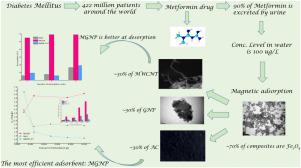Chemical Engineering Research and Design ( IF 3.7 ) Pub Date : 2021-02-09 , DOI: 10.1016/j.cherd.2021.01.034 Ferda Civan Çavuşoğlu , Şahika Sena Bayazit , Marius Sebastian Secula , Benoît Cagnon

|
The present work describes three newly-prepared magnetic-carbon composites (M-CCs) applied as adsorbents. The M-CCs were prepared by the co-precipitation method, grafting Fe(II) and Fe(III) oxides onto the surface of different matrices: PAC, GNP and MWCNT in order to achieve M-PAC, M-GNP and M-MWCNT, respectively. The composites were characterized by Fourier Transform Infrared spectroscopy, X-ray Diffraction Spectroscopy. Scanning Electron Microscopy was used for characterization of M-MWCNTs, Transmission Electron Microscopy was used for characterization of M-GNP composites. Thermogravimetric analyses were performed for each of the three M-CCs. It is found that about 70% of M-CCs consist in Fe3O4 nanoparticles. M-CCs adsorption features and performance towards the removal of a pollutant model from aqueous solutions was established. They were tested for Metformin hydrochloride adsorption, a worldwide antidiabetic pharmaceutical agent. The parameters of adsorbent dose, adsorption duration, initial concentration of adsorbate solution, temperature, pH and co-existing ion concentration were considered as adsorption independent variables. The kinetic tests show that the Pseudo second order kinetic model (PSO) fit best the three-adsorption systems. M-GNP is the fastest adsorbent of the three (k2 = 0.36 g/mg min). The three investigated adsorption systems obey the Langmuir isotherm model. Pinpointing M-GNP (qm = 8.83 mg/g) as the most efficient adsorbent in normal conditions, and M-MWCNT (qm = 26.17 mg/g at 318 K) at higher values of temperature. Acid conditions favor adsorption of Metformin hydrochloride onto M-MWCNT, alkaline for M-PAC, whereas M-GNP provides best performance under amphoteric conditions. Coexisting ions affected Metformin hydrochloride adsorption only in case of M-MWCNT and M-GNP. Desorption tests were also carried out by using phosphate buffer solution. M-GNP provides best desorption ratios, reaching nearly 66% of Metformin hydrochloride desorption after each use.
中文翻译:

磁性碳复合材料作为可再生和完全可回收的吸附剂:去除抗糖尿病药盐酸二甲双胍的性能
本工作描述了三种新制备的用作吸附剂的磁性碳复合材料(M-CC)。M-CC通过共沉淀法制备,将Fe(II)和Fe(III)氧化物接枝到不同基质(PAC,GNP和MWCNT)的表面上,以实现M-PAC,M-GNP和M- MWCNT,分别。通过傅立叶变换红外光谱,X射线衍射光谱对复合材料进行表征。扫描电子显微镜用于表征M-MWCNT,透射电子显微镜用于表征M-GNP复合材料。对三个M-CC中的每一个进行热重分析。发现大约70%的M-CCs包含在Fe 3 O 4中纳米粒子。建立了M-CCs吸附特征和从水溶液中去除污染物模型的性能。对它们进行了盐酸二甲双胍吸附的测试,这是一种全球性的抗糖尿病药物。吸附剂剂量,吸附持续时间,吸附物溶液的初始浓度,温度,pH和共存离子浓度等参数均被视为吸附独立变量。动力学测试表明,伪二级动力学模型(PSO)最适合三吸附系统。M-GNP是这三种中最快的吸附剂(k 2 = 0.36 g / mg min)。研究的三个吸附系统遵循Langmuir等温模型。精确定位M-GNP(q m 在正常条件下为最有效的吸附剂,吸附量为8.83 mg / g; 在较高温度下,M-MWCNT(在318 K下,q m = 26.17 mg / g)是最有效的吸附剂。酸性条件有利于盐酸二甲双胍吸附在M-MWCNT上,对M-PAC呈碱性,而M-GNP在两性条件下提供最佳性能。仅在M-MWCNT和M-GNP的情况下,共存离子才影响盐酸二甲双胍的吸附。还通过使用磷酸盐缓冲溶液进行了脱附测试。M-GNP提供最佳的脱附率,每次使用后达到接近二甲双胍盐酸盐脱附率的66%。











































 京公网安备 11010802027423号
京公网安备 11010802027423号